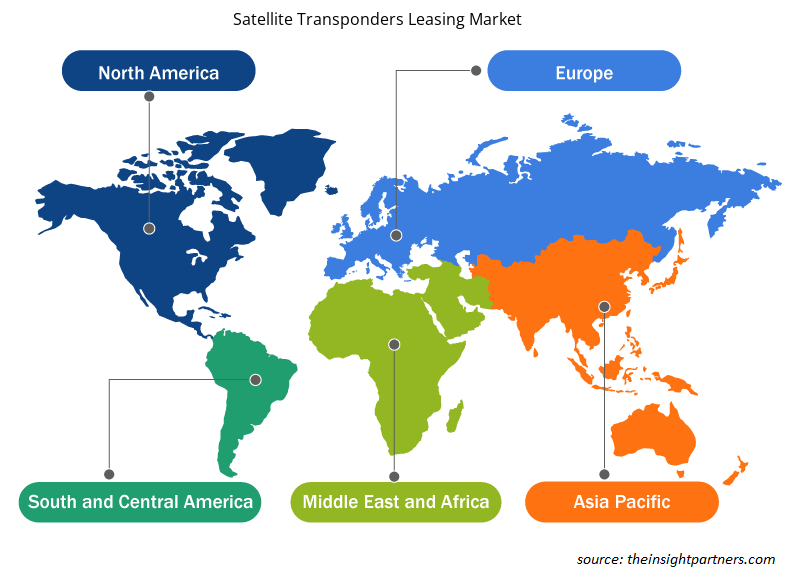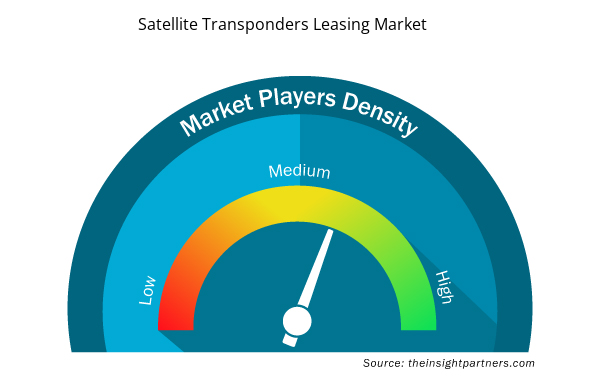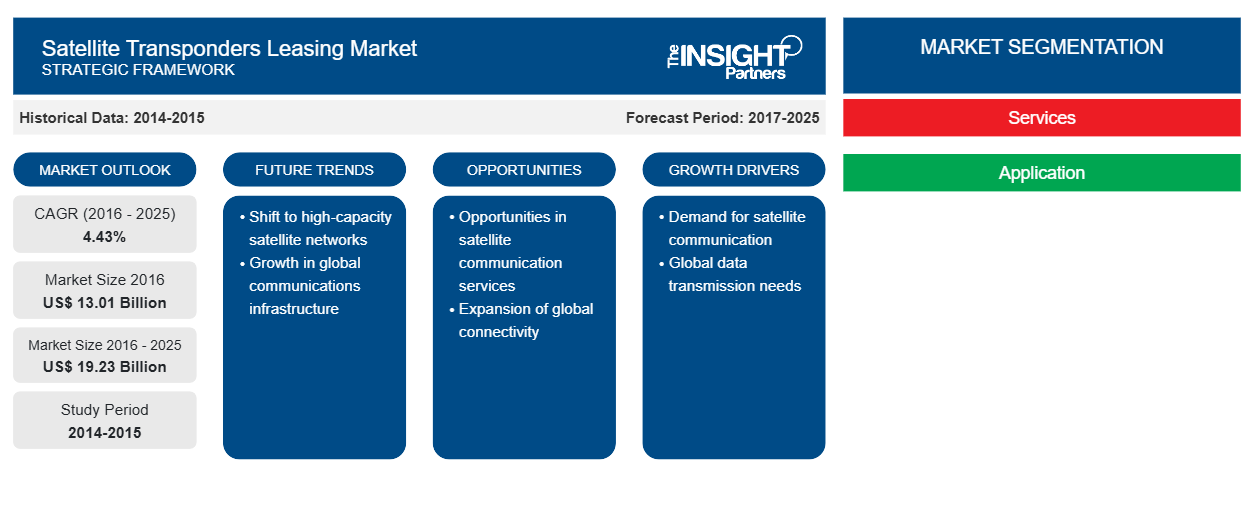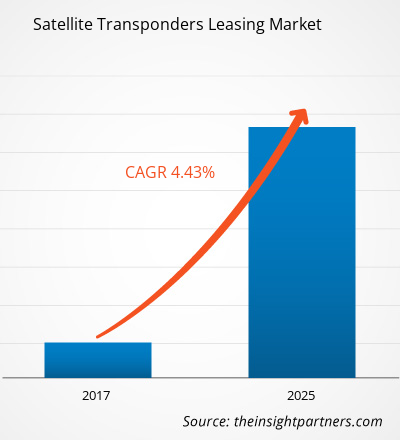من المتوقع أن ينمو سوق تأجير أجهزة الإرسال والاستقبال عبر الأقمار الصناعية من 13.01 مليار دولار أمريكي في عام 2016 إلى 19.23 مليار دولار أمريكي بحلول عام 2025 بمعدل نمو سنوي مركب قدره 4.43٪ بين عامي 2016 و 2025.
من المتوقع أن ينمو سوق تأجير أجهزة الإرسال والاستقبال عبر الأقمار الصناعية من حيث التغطية والقدرة حيث أن ترددات النطاق Ka و Ku تعمل على تغذية نمو السوق، علاوة على ذلك، من المتوقع أيضًا أن يؤدي العدد المتزايد من تحديثات المشتركين والمشتركين الجدد إلى دفع سوق أجهزة الإرسال والاستقبال عبر الأقمار الصناعية العالمية. علاوة على ذلك، نظرًا للتقدم التكنولوجي الحالي في اتصالات الأقمار الصناعية، من المتوقع ظهور العديد من التطبيقات الجديدة لأجهزة الإرسال والاستقبال عبر الأقمار الصناعية. تعتبر هذه الأقمار الصناعية قوية بما يكفي للتنافس مع منافسيها؛ النطاق العريض لخط المشترك الرقمي (DSL) من حيث أدائها. ومن المتوقع أن تعمل كل هذه العوامل على تغذية سوق تأجير أجهزة الإرسال والاستقبال عبر الأقمار الصناعية العالمية خلال فترة التنبؤ.
رؤى السوق
التوسع في تطبيقات النطاق Ku لتوليد فرص جديدة لسوق تأجير أجهزة الإرسال والاستقبال الخاصة بالأقمار الصناعية للاتصالات
يعد البث المباشر وتوزيع الفيديو من أهم التطبيقات التي تستخدمها أقمار النطاق الترددي Ku، كما تستخدم في العديد من خدمات البيانات بما في ذلك خدمات VSAT، والاتصال عريض النطاق، والنقل الخلفي عبر الهاتف المحمول، والخدمات الجوية والبحرية. وفي هذا العالم المتصل بشكل كبير، تعتبر كل هذه التطبيقات بالغة الأهمية لعمل الشركات/المؤسسات. في الواقع، يعد النطاق الترددي Ku هو الطيف الرئيسي الذي تستخدمه شبكات التنقل من أجل توفير الاتصال عريض النطاق في المنطقة التي لا تستطيع الشبكات الأرضية الوصول إليها، أي عبر المحيط وفي طبقة التروبوسفير. يستحوذ النطاق الترددي Ku على ما يقرب من 40% من السوق من حيث النطاق الترددي. ومن المتوقع أن يزداد الطلب على أجهزة الإرسال والاستقبال Ku بسبب زيادة رواج أجهزة التلفزيون الفضائية بشكل خاص في الاقتصادات النامية، وهو ما يدعمه أيضًا HD (عالي الدقة) والطلب على تطبيقات النطاق الترددي المماثلة الأخرى. ومن المتوقع أن يوفر تطور القنوات ثلاثية الأبعاد التي تستهلك نطاقًا تردديًا أعلى وتتطلب سعة أكبر بنسبة 50% دفعة جديدة لسوق أجهزة الإرسال والاستقبال Ku عبر الأقمار الصناعية. وتأتي أجهزة الإرسال والاستقبال ذات النطاق C في المرتبة التالية في السوق حاليًا، ولكن من المتوقع أن تشهد انخفاضًا ثابتًا خلال فترة التوقعات، مما يؤدي إلى فقدان أهميتها لصالح نطاق Ku وغيره من النطاقات الترددية المماثلة. وبالتالي، من المتوقع أن يؤدي هذا التوسع في تطبيقات النطاق Ku إلى توليد فرص جديدة لسوق تأجير أجهزة الإرسال والاستقبال عبر الأقمار الصناعية
تأجير أجهزة الإرسال والاستقبال كخدمات للسيطرة على قطاع الخدمة العالمي لسوق تأجير أجهزة الإرسال والاستقبال عبر الأقمار الصناعية
منذ العام أو العامين الماضيين، شهد سوق أجهزة الإرسال والاستقبال عبر الأقمار الصناعية العالمية ارتفاعًا بنسبة 4.3-4.5% تقريبًا في الطلب على أجهزة الإرسال والاستقبال المؤجرة. ومن المتوقع أن يزداد هذا الطلب بسبب ارتفاع تكلفة أجهزة الإرسال والاستقبال في جميع أنحاء العالم. بالنظر إلى سوق تأجير أجهزة الإرسال والاستقبال عبر الأقمار الصناعية، يُلاحظ أن أوروبا هي المنطقة الأكثر تكلفة تليها أستراليا ونيوزيلندا. في حين تقدم جنوب آسيا أدنى أسعار التأجير، ولهذا السبب تعتبر منطقة آسيا والمحيط الهادئ المنطقة الأكثر وعدًا لسوق تأجير أجهزة الإرسال والاستقبال عبر الأقمار الصناعية في السنوات القادمة. مؤخرًا، وقعت شركة الأقمار الصناعية الكورية KT SAT اتفاقية تأجير أجهزة إرسال واستقبال مع مشغل تلفزيوني عبر الأقمار الصناعية منغوليا، حيث قام مزود الخدمة KT SAT بتأجير أربعة أجهزة إرسال واستقبال تابعة، مما من شأنه أن يحقق الغرض من تقديم خدمات DTH للشركات المنغولية التي يتم إطلاقها في العام المقبل. في حين أنه من المتوقع أن تستفيد شركة DDISH TV من خدمات KT SATs في عام 2017. يعتمد تأجير أجهزة إرسال واستقبال الأقمار الصناعية للاتصالات بشكل كبير على تبني البث المرئي عالي الدقة وانتشار تطبيقات النطاق الديناميكي العالي (HDR). على الرغم من أنه من المتوقع أن تقود خدمات التأجير سوق تأجير أجهزة إرسال واستقبال الأقمار الصناعية بحصة سوقية أعلى نسبيًا، والتي تخضع للتقلبات اعتمادًا على مراجعة تكلفة شراء أجهزة إرسال واستقبال الأقمار الصناعية والتكلفة الإجمالية لإطلاق القمر الصناعي وصيانته.
قم بتخصيص هذا التقرير ليناسب متطلباتك
ستحصل على تخصيص لأي تقرير - مجانًا - بما في ذلك أجزاء من هذا التقرير، أو تحليل على مستوى الدولة، وحزمة بيانات Excel، بالإضافة إلى الاستفادة من العروض والخصومات الرائعة للشركات الناشئة والجامعات
- احصل على أهم اتجاهات السوق الرئيسية لهذا التقرير.ستتضمن هذه العينة المجانية تحليلاً للبيانات، بدءًا من اتجاهات السوق وحتى التقديرات والتوقعات.
لوحظت مبادرة السوق باعتبارها الاستراتيجية الأكثر اعتماداً في سوق تأجير أجهزة الإرسال والاستقبال عبر الأقمار الصناعية العالمية. وفيما يلي قائمة ببعض الاستراتيجيات الحديثة التي تبناها بعض اللاعبين في سوق تأجير أجهزة الإرسال والاستقبال عبر الأقمار الصناعية:
2016: GlobalSat ترخص خدمات Inmarsat Ka وL-band في جميع أنحاء المكسيك
2016: MVS USA تقوم بتحديث شبكة Satcom مع التركيز على الأمن السيبراني
2016: O3b وOzonio يجلبان النطاق العريض إلى مدينة أخرى في منطقة الأمازون في البرازيل
2016: المدارس الأفريقية ستستفيد من صفقة غازبروم-جيلات الجديدة
2016: إندونيسيا تبني إمكانية الوصول إلى النطاق العريض في المناطق التي تعاني من نقص الخدمات مع شركة Newtec
نظرة إقليمية على سوق تأجير أجهزة الإرسال والاستقبال عبر الأقمار الصناعية
لقد قام المحللون في Insight Partners بشرح الاتجاهات والعوامل الإقليمية المؤثرة على سوق تأجير أجهزة الإرسال والاستقبال عبر الأقمار الصناعية طوال فترة التوقعات بشكل شامل. يناقش هذا القسم أيضًا قطاعات سوق تأجير أجهزة الإرسال والاستقبال عبر الأقمار الصناعية والجغرافيا في جميع أنحاء أمريكا الشمالية وأوروبا ومنطقة آسيا والمحيط الهادئ والشرق الأوسط وأفريقيا وأمريكا الجنوبية والوسطى.

- احصل على البيانات الإقليمية المحددة لسوق تأجير أجهزة الإرسال والاستقبال عبر الأقمار الصناعية
نطاق تقرير سوق تأجير أجهزة الإرسال والاستقبال عبر الأقمار الصناعية
| سمة التقرير | تفاصيل |
|---|---|
| حجم السوق في عام 2016 | 13.01 مليار دولار أمريكي |
| حجم السوق بحلول عام 2025 | 19.23 مليار دولار أمريكي |
| معدل النمو السنوي المركب العالمي (2016 - 2025) | 4.43% |
| البيانات التاريخية | 2014-2015 |
| فترة التنبؤ | 2017-2025 |
| القطاعات المغطاة | حسب الخدماتحسب التطبيقحسب النطاق الترددي |
| المناطق والدول المغطاة | أمريكا الشمالية
|
| قادة السوق وملفات تعريف الشركات الرئيسية |
|
كثافة اللاعبين في السوق: فهم تأثيرها على ديناميكيات الأعمال
يشهد سوق تأجير أجهزة الإرسال والاستقبال عبر الأقمار الصناعية نموًا سريعًا، مدفوعًا بالطلب المتزايد من المستخدم النهائي بسبب عوامل مثل تفضيلات المستهلكين المتطورة والتقدم التكنولوجي والوعي المتزايد بفوائد المنتج. ومع ارتفاع الطلب، تعمل الشركات على توسيع عروضها والابتكار لتلبية احتياجات المستهلكين والاستفادة من الاتجاهات الناشئة، مما يؤدي إلى زيادة نمو السوق.
تشير كثافة اللاعبين في السوق إلى توزيع الشركات أو المؤسسات العاملة في سوق أو صناعة معينة. وهي تشير إلى عدد المنافسين (اللاعبين في السوق) الموجودين في مساحة سوق معينة نسبة إلى حجمها أو قيمتها السوقية الإجمالية.
الشركات الرئيسية العاملة في سوق تأجير أجهزة الإرسال والاستقبال عبر الأقمار الصناعية هي:
- إنتلسات
- خدمة العملاء
- يوتلسات
- تيليسات
- سنغ تيل اوبتوس
إخلاء المسؤولية : الشركات المذكورة أعلاه ليست مرتبة بأي ترتيب معين.

- احصل على نظرة عامة على أهم اللاعبين الرئيسيين في سوق تأجير أجهزة الإرسال والاستقبال عبر الأقمار الصناعية
تأجير أجهزة الإرسال والاستقبال عبر الأقمار الصناعية العالمية - تقسيم السوق
حسب الخدمات
- محمي
- غير محمي
- قابلة للإلغاء
حسب الطلب
- الحكومة والجيش
- الاتصالات
- تجاري
- البحث والتطوير
- ملاحة
- الاستشعار عن بعد
حسب النطاق الترددي
- فرقة كيو
- كا باند
- نطاق C
- أخرى (S, L, X & K)
حسب الجغرافيا
- أمريكا الشمالية
- نحن
- كندا
- المكسيك
- أوروبا
- روسيا
- فرنسا
- ألمانيا
- المملكة المتحدة
- لوكسمبورج
- بقية أوروبا
- آسيا والمحيط الهادئ (APAC)
- الصين
- الهند
- اليابان
- بقية منطقة آسيا والمحيط الهادئ
- الشرق الأوسط وأفريقيا
- المملكة العربية السعودية
- جنوب أفريقيا
- إسرائيل
- الامارات العربية المتحدة
- باقي منطقة الشرق الأوسط وأفريقيا
- أمريكا الجنوبية (SAM)
- البرازيل
- الأرجنتين
- بقية سام
نبذة عن الشركة
- إنتلسات
- خدمة العملاء
- يوتلسات
- تيليسات
- سنغ تيل اوبتوس
- أنظمة الأقمار الصناعية MEASAT
- آسيا للبث عبر الأقمار الصناعية
- عربسات
- منظمة أبحاث الفضاء الهندية
- شركة الصين للاتصالات عبر الأقمار الصناعية
- التحليل التاريخي (سنتان)، السنة الأساسية، التوقعات (7 سنوات) مع معدل النمو السنوي المركب
- تحليل PEST و SWOT
- حجم السوق والقيمة / الحجم - عالميًا وإقليميًا وقطريًا
- الصناعة والمنافسة
- مجموعة بيانات Excel


- Passport Reader Market
- Compounding Pharmacies Market
- Machine Condition Monitoring Market
- Environmental Consulting Service Market
- Arterial Blood Gas Kits Market
- Intraoperative Neuromonitoring Market
- Online Exam Proctoring Market
- High Speed Cable Market
- Hydrocephalus Shunts Market
- Industrial Inkjet Printers Market

Report Coverage
Revenue forecast, Company Analysis, Industry landscape, Growth factors, and Trends

Segment Covered
This text is related
to segments covered.

Regional Scope
North America, Europe, Asia Pacific, Middle East & Africa, South & Central America

Country Scope
This text is related
to country scope.
The List of Companies - Satellite Transponders Leasing Market
- Intelsat
- SES
- Eutelsat
- Telesat
- SingTel Optus
- MEASAT satellite systems
- Asia Broadcast Satellite
- Arabsat
- ISRO
- China Satellite Communications Co.
The Insight Partners performs research in 4 major stages: Data Collection & Secondary Research, Primary Research, Data Analysis and Data Triangulation & Final Review.
- Data Collection and Secondary Research:
As a market research and consulting firm operating from a decade, we have published and advised several client across the globe. First step for any study will start with an assessment of currently available data and insights from existing reports. Further, historical and current market information is collected from Investor Presentations, Annual Reports, SEC Filings, etc., and other information related to company’s performance and market positioning are gathered from Paid Databases (Factiva, Hoovers, and Reuters) and various other publications available in public domain.
Several associations trade associates, technical forums, institutes, societies and organization are accessed to gain technical as well as market related insights through their publications such as research papers, blogs and press releases related to the studies are referred to get cues about the market. Further, white papers, journals, magazines, and other news articles published in last 3 years are scrutinized and analyzed to understand the current market trends.
- Primary Research:
The primarily interview analysis comprise of data obtained from industry participants interview and answers to survey questions gathered by in-house primary team.
For primary research, interviews are conducted with industry experts/CEOs/Marketing Managers/VPs/Subject Matter Experts from both demand and supply side to get a 360-degree view of the market. The primary team conducts several interviews based on the complexity of the markets to understand the various market trends and dynamics which makes research more credible and precise.
A typical research interview fulfils the following functions:
- Provides first-hand information on the market size, market trends, growth trends, competitive landscape, and outlook
- Validates and strengthens in-house secondary research findings
- Develops the analysis team’s expertise and market understanding
Primary research involves email interactions and telephone interviews for each market, category, segment, and sub-segment across geographies. The participants who typically take part in such a process include, but are not limited to:
- Industry participants: VPs, business development managers, market intelligence managers and national sales managers
- Outside experts: Valuation experts, research analysts and key opinion leaders specializing in the electronics and semiconductor industry.
Below is the breakup of our primary respondents by company, designation, and region:

Once we receive the confirmation from primary research sources or primary respondents, we finalize the base year market estimation and forecast the data as per the macroeconomic and microeconomic factors assessed during data collection.
- Data Analysis:
Once data is validated through both secondary as well as primary respondents, we finalize the market estimations by hypothesis formulation and factor analysis at regional and country level.
- Macro-Economic Factor Analysis:
We analyse macroeconomic indicators such the gross domestic product (GDP), increase in the demand for goods and services across industries, technological advancement, regional economic growth, governmental policies, the influence of COVID-19, PEST analysis, and other aspects. This analysis aids in setting benchmarks for various nations/regions and approximating market splits. Additionally, the general trend of the aforementioned components aid in determining the market's development possibilities.
- Country Level Data:
Various factors that are especially aligned to the country are taken into account to determine the market size for a certain area and country, including the presence of vendors, such as headquarters and offices, the country's GDP, demand patterns, and industry growth. To comprehend the market dynamics for the nation, a number of growth variables, inhibitors, application areas, and current market trends are researched. The aforementioned elements aid in determining the country's overall market's growth potential.
- Company Profile:
The “Table of Contents” is formulated by listing and analyzing more than 25 - 30 companies operating in the market ecosystem across geographies. However, we profile only 10 companies as a standard practice in our syndicate reports. These 10 companies comprise leading, emerging, and regional players. Nonetheless, our analysis is not restricted to the 10 listed companies, we also analyze other companies present in the market to develop a holistic view and understand the prevailing trends. The “Company Profiles” section in the report covers key facts, business description, products & services, financial information, SWOT analysis, and key developments. The financial information presented is extracted from the annual reports and official documents of the publicly listed companies. Upon collecting the information for the sections of respective companies, we verify them via various primary sources and then compile the data in respective company profiles. The company level information helps us in deriving the base number as well as in forecasting the market size.
- Developing Base Number:
Aggregation of sales statistics (2020-2022) and macro-economic factor, and other secondary and primary research insights are utilized to arrive at base number and related market shares for 2022. The data gaps are identified in this step and relevant market data is analyzed, collected from paid primary interviews or databases. On finalizing the base year market size, forecasts are developed on the basis of macro-economic, industry and market growth factors and company level analysis.
- Data Triangulation and Final Review:
The market findings and base year market size calculations are validated from supply as well as demand side. Demand side validations are based on macro-economic factor analysis and benchmarks for respective regions and countries. In case of supply side validations, revenues of major companies are estimated (in case not available) based on industry benchmark, approximate number of employees, product portfolio, and primary interviews revenues are gathered. Further revenue from target product/service segment is assessed to avoid overshooting of market statistics. In case of heavy deviations between supply and demand side values, all thes steps are repeated to achieve synchronization.
We follow an iterative model, wherein we share our research findings with Subject Matter Experts (SME’s) and Key Opinion Leaders (KOLs) until consensus view of the market is not formulated – this model negates any drastic deviation in the opinions of experts. Only validated and universally acceptable research findings are quoted in our reports.
We have important check points that we use to validate our research findings – which we call – data triangulation, where we validate the information, we generate from secondary sources with primary interviews and then we re-validate with our internal data bases and Subject matter experts. This comprehensive model enables us to deliver high quality, reliable data in shortest possible time.


 احصل على عينة مجانية لهذا التقرير
احصل على عينة مجانية لهذا التقرير